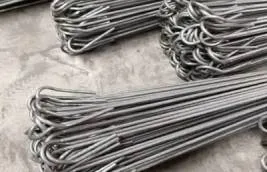-
 Phone:
Phone: -
 Email:
Email:

Innovative Applications of Tie Steel Wire in Construction and Industry
The Versatility and Strength of Tie Steel Wire
Tie steel wire, often overlooked in the broader spectrum of materials, is a crucial component in various industries, particularly in construction, manufacturing, and agriculture. This article delves into the characteristics, applications, and advantages of tie steel wire, highlighting its significance in modern engineering and construction.
Understanding Tie Steel Wire
Tie steel wire is characterized by its high tensile strength and flexibility. It is typically made from carbon steel, which provides enhanced durability and resistance to deformation. This type of wire can be easily twisted, bent, or shaped, making it an ideal choice for a myriad of applications. The diameter of tie steel wire can vary depending on its intended use, ranging from thin gauges suitable for light applications to thicker versions capable of sustaining substantial loads.
Applications in Construction
In the construction industry, tie steel wire is predominantly used for reinforcing concrete structures. It serves as a vital component of rebar, helping to hold the reinforcing bars in place during the concrete pouring process. The wire's strength allows it to absorb and distribute tension, ensuring the stability and integrity of buildings, bridges, and other structures. Additionally, it is used for tie-offs during the assembly of formwork and scaffolding, providing temporary support and stability.
Furthermore, tie steel wire plays an essential role in masonry work
. It is often utilized to bind bricks and blocks, ensuring they adhere firmly together and increasing the overall strength of the structure. The wire's flexibility makes it easy for workers to weave it in and out of the masonry, thus enhancing the durability of walls and facades.Agricultural Applications
tie steel wire

In agriculture, tie steel wire is invaluable for various functions. Farmers frequently use it for fencing, creating a robust barrier to contain livestock and protect crops from wildlife. The wire's resistance to rust and corrosion ensures a long lifespan, reducing the need for frequent replacements. Moreover, tie steel wire is employed in the construction of trellises and frameworks for climbing plants, supporting the healthy growth of crops such as tomatoes, grapes, and cucumbers.
Advantages of Tie Steel Wire
One of the primary advantages of tie steel wire is its high tensile strength, enabling it to withstand significant loads without deformation. This property makes it ideal for structural applications where safety and reliability are paramount. Additionally, its flexibility allows for ease of use, making it accessible for workers without requiring specialized tools or training.
Another significant benefit is its cost-effectiveness. Tie steel wire is relatively inexpensive compared to other materials, making it an attractive option for various projects. Its long lifespan and minimal maintenance requirements further contribute to its economic appeal.
Environmental Considerations
As industries move towards more sustainable practices, tie steel wire can also play a role in eco-friendly construction. It is often made from recyclable materials, reducing the environmental impact of production and disposal. Furthermore, the durability of tie steel wire means that structures built with it require less frequent repairs and replacements, contributing to resource conservation.
Conclusion
Tie steel wire, while seemingly mundane, is a critical material that enhances the strength, stability, and durability of structures across numerous industries. From construction and agriculture to manufacturing, its versatility and cost-effectiveness make it an indispensable tool for professionals. As we continue to innovate and prioritize sustainable practices, the role of tie steel wire in our built environment will undoubtedly evolve, cementing its place as a vital component of modern engineering.
-
Wire Mesh for Every Need: A Practical SolutionNewsJul.25,2025
-
Steel Fences: Durable, Secure, and Stylish OptionsNewsJul.25,2025
-
Roll Top Fencing: A Smart Solution for Safety and SecurityNewsJul.25,2025
-
Cattle Farm Fencing Solutions for Maximum SecurityNewsJul.25,2025
-
Affordable Iron Binding Wire SolutionsNewsJul.25,2025
-
Affordable Galvanized Wire SolutionsNewsJul.25,2025
-
Wire Hanger Recycling IdeasNewsJul.25,2025








